View this article in another language
- 한국어
- English
- 日本語
- 中文
- العربية
- Español
- Français
- Deutsch
- Pусский
- Tiếng Việt
- Indonesian
This is the seventh part in our series, “Alcohol in Korean life.” Click here to see previous posts.
Sul and Customs
Seasonal Customs
The Korean people have long enjoyed festivals and celebrations tied to the seasonal changes throughout the year. People would give thanks to the deities or ancestral spirits and share the joy and camaraderie with their neighbors and community. Alcohol has always been an indispensible element when celebrating these seasonal customs. The drinks were made with different ingredients during the different seasons and took on different meanings on different occasions.
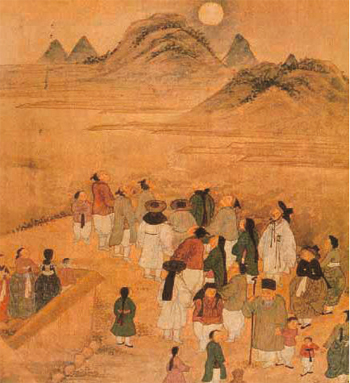 The first day of the first lunar month is New Year’s Day, or Seollal, when Koreans visit other members of the family and neighbors to render the traditional New Year’s bows to their elders and are treated to sechan, or the New Year’s feast. Special dishes of rice, seafood, meat, eggs and dried persimmons are served, along with seju or New Year’s liquor. Seju is mostly cheongju or yakju prepared in the summer of the previous year.
The first day of the first lunar month is New Year’s Day, or Seollal, when Koreans visit other members of the family and neighbors to render the traditional New Year’s bows to their elders and are treated to sechan, or the New Year’s feast. Special dishes of rice, seafood, meat, eggs and dried persimmons are served, along with seju or New Year’s liquor. Seju is mostly cheongju or yakju prepared in the summer of the previous year.
Dosoju, literally "liquor for fending off evil spirits," is also consumed on New Year’s Day in the belief that it would defeat spirits of misfortune throughout the year. Invented by the Chinese doctor Hwata, dosoju is made by soaking powdered medicinal ingredients, such as Chinese peppers or balloon-flower root in clear rice wine for a while, scooping them out and then boiling the medicinal liquor.
The fifteenth day of the first lunar month is Daeboreum, when Koreans drink “ear-quickening wine,” believed that it would make them quick to hear good news throughout the year. Children just sip a cup of the wine and the leftover is poured over the chimney so that evil spirits would disappear along with the smoke from the hearth.
The first day of the second lunar month is Junghwajeol which signals the start of the farming season. On Junghwajeol, festivals were held for farm servants to wish for a good harvest and they were treated to nongju, or farmers’ liquor. Youths who hadn’t yet had their coming-of-age ceremony would receive a big bowl of the liquor to signify that they were now grown-up and from that day forward they would be granted the same wage as an adult.
The third day of the third lunar month is Samjinnal when Koreans go on a picnic to enjoy the beginning of spring and flowers come into bloom. For spring picnics, the most popular alcoholic beverage is dugyeonju made of azalea flowers. Around this time of year, cheongmyeongju and gwahaju were also enjoyed. Cheongmyeongju, literally “clear clean wine,” is a kind of cheongju fermented for 21 days. It has an intense sweet flavor good even for those who don’t enjoy drinking much alcohol. Gwahaju means “liquor for getting through the summer without trouble” and it was sold at drinking houses at this time of year.
In April when the northern hemisphere is in its springtime, all living things begin to grow and farming starts in earnest. Individual households would hire one or two farm workers and form labor-sharing associations, such as durae, a type of communal agricultural team. Farm workers were treated to plentiful amounts of takju made of nuruk and rice.
The fifth day of the fifth lunar month is Dano when men traditionally play a ball game and women play on swings, and everyone enjoys the blooming nature. Women wash their hair in water boiled with iris roots and leaves, believed to chase away diseases. Iris is also used to make liquor. A pack of iris roots is steeped in cheongju so that their fragrance could be transferred to the liquor.
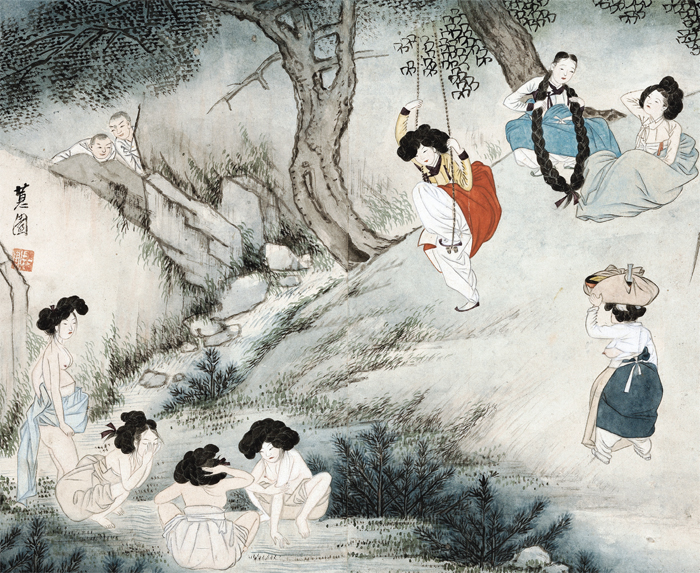
The fifteenth day of the sixth lunar month is Yudujeol, literally “the day when people wash their hair in water flowing to the east.” Avoiding the summer heat, Korean enjoyed drinking at a nearby stream.
The fifteenth day of the seventh lunar month is Baekjungnal. The root word baekjung literally means “among a hundred,” denoting that various kinds of fruits and vegetables are produced in large amounts around this time of year. Vegetables, fruits, rice and liquor are arranged on a table as a ritual offering for the souls of dead ancestors. Around this time when farming is on a temporary break, the “hoe cleaning” ceremony is observed when farm workers take a pleasant break feasting on food and liquor. Farm servants from the household expecting the most abundant harvest would ride a cow and roam the village to be treated to free liquor. Some would cavort around in makeshift cow costumes of straw mats, earning treats of alcohol from neighbors for their antics.
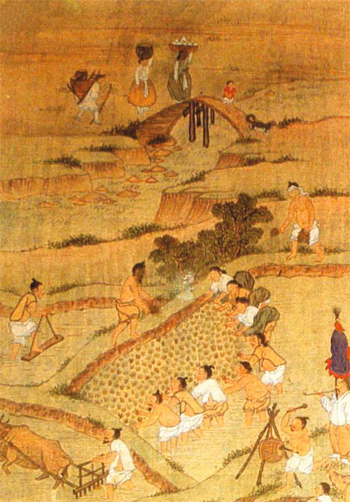
The fifteenth day of the eighth lunar month is Chuseok, or Hangawi, when Koreans set a ritual table for ancestral spirits and tend the graveyards of ancestors. After sprucing up their forefathers’ tombs, foods and liquor are shared among family members. On Chuseok, a variety of alcoholic beverages are consumed, particularly dongdongju, a kind of takju made of glutinous rice and nuruk.
The ninth day of the ninth lunar month is Jungyangjeol, a double-nine day considered auspicious, bringing about good “energy.” On this day state events were held, such as festivals honoring senior literary luminaries, and people picnicked on nearby mountains and composed poems and wrote surrounded by colorful maples and chrysanthemums. On this day, they consumed fruit salads, flower cakes and chrysanthemum liquor made by soaking chrysanthemum petals in cheongju and filtering it.
Ancestral rites are conducted to report the year’s accomplishments around the fifteenth day of the tenth lunar month. Visiting their forebears’ graveyards, Koreans conduct family rituals for up to five generations of ancestors and share the food and alcoholic beverages offered at the rites.
The last day of the twelfth month is called the “small New Year’s Day,” when Koreans send off the current year and welcome the new year. On this day, they pay tribute at ancestors’ tombs, perform ritual bows to parents and elder members of the family and share food and alcoholic beverages.
Rites of Passage
Alcohol is the most important table offering during family rituals which mark the four significant milestones: coming-of-age, weddings, funerals and ancestral rituals.
Gwallye, or Coming-of-Age Ceremonies
A gwallye is a coming-of-age ceremony to mark the transition from childhood to adulthood. Mostly taking place between the ages of 15 to 20, boys would wear a gat, a traditional Korean top hat, and girls would wear their braids secured with a binyeo, a traditional ornamental hairpin. Even though unmarried, they are received as adults after the coming-of-age ceremony.
Before the ceremony, the youth visits the family’s ancestral shrine to notify their forebears of the transition to adulthood by offering fruits and alcoholic beverages. A guest of honor is invited to preside at the ceremony and plays a similar role as a baptismal grandfather in some Christian rites. The person is normally selected from amongst friends of the head of the family and is generally a gentle and courteous guardian.
A gwallye ceremony consists of three steps. First, the celebrant wears three different types of adult attire, denoting his or her separation from childhood and his or her entrance into adulthood. Second, the new adult is given some liquor to drink. When the guest of honor offers a cup of liquor after delivering a ceremonial speech, the celebrant bows twice to the guest of honor, receives the cup, puts it on the table for a while, picks it up, takes a sip, hands it over to a ceremonial assistant and then again bows to the guest of honor. The procedure symbolizes that drinking is associated with the start of a new status or a new relationship. Third, the guest of honor endows a new name to the youth to make a fresh start as an adult.
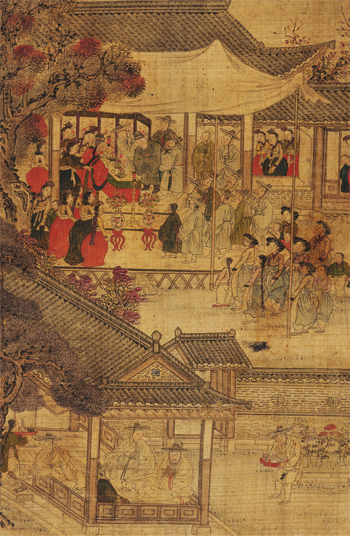 Hollye, or Weddings
Hollye, or Weddings
At a wedding, the bride and groom exchange haphwanju, or nuptial cups. The bride offers her cup to the groom and in return the groom offers his cup to the bride. Then they exchange cups. Since nuptial cups symbolize a happy union lasting throughout life, even a bride or groom who does not want to drink should at least wet their lips from the haphwanju. After the wedding ceremony, the bride and the groom enter a room where juansang, a table set with liquor and side dishes awaits them, where they can “break the rice” between them.
Since a wedding ceremony is traditionally held at the bride’s house, the couple goes to the groom’s house after one night together. Upon arriving at the groom’s house, the bride sets a table of chicken, chestnuts, fruit and side dishes brought from her house along with alcoholic beverages.
Wedding guests are treated to honsatsul, or wedding liquor. The process of making the wedding liquor requires the utmost attention and care. Guests are expected to judge the wedding foods and the couple’s appearance, and a positive evaluation of the wedding liquor is believed to bring about a lifetime of good fortune for the newlywed couple.
Sangnye, or Funerals
Koreans do not think of death as the end of life, but believe that people would complete this life and the dead would go back to their original place of existence before they were born into this life. That is why funerals are conducted both with sorrow and pleasure.
Sangnye starts and ends with liquor. Family member, friends and neighbors visit the funeral home to offer their condolences and stay up all night drinking together as a way of sharing their sadness and warding off bad fortune.
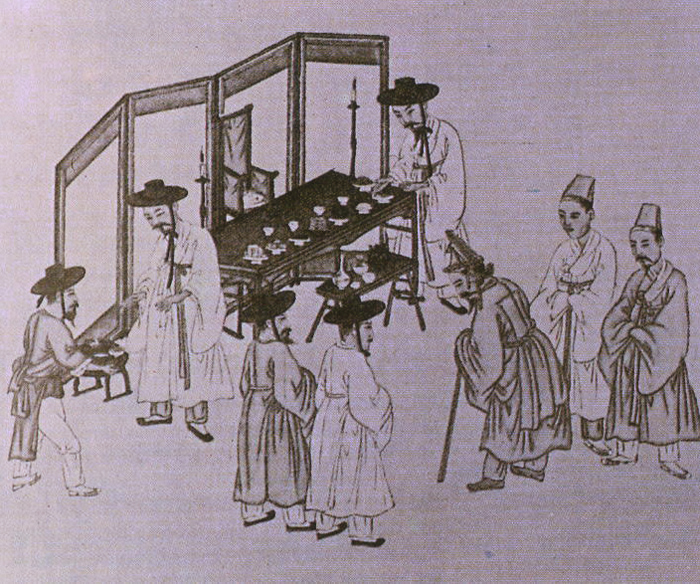
About 10 people carry the coffin containing the body to the graveyard while singing. The funeral party does not head directly for the graveyard, but stops by each of the places frequented by the dead person, where a liquor table is set for a farewell ceremony, and the pallbearers and people in the funeral procession have drinks together. The coffin is finally laid in the grave and poured with liquor, and then people bow before a table set with liquor in front of the grave upon completion of the burial.
Jerye, or Ancestral Rites
Observing ancestral rites is a deeply traditional cultural practice in Korea. Ceremonial rituals for forebears are conducted on seasonal customary festivals, such as New Year’s Day, Hansik in April, Dano, Chuseok and the dates of birth and death of the ancestors. Well-off or successful families tended to carry out more ancestral rites throughout the year.
A ritual table is filled with offerings of liquor, fruit, preserved meat and cups of liquor are offered after ceremonial bows. Three cups of liquor are offered: the first by the eldest son of the family who would then read a memorial address, the second by his wife and the third by the oldest member of the family. After the third cup, the cups are filled to the brim once again and descendants step back from the table so that ancestral spirits enjoy the meal undisturbed. With the final ceremonial bow, the ritual is completed and the foods and rinks removed from the table are shared amongst the family members as a way of sharing the blessings from their ancestors.
In the past, families privately brewed their own alcoholic beverages for ancestral rituals. Koreans believed that if ritual liquor was not made properly, or if it went bad, bad fortune would come to them. Therefore, they paid every care and attention to the making of drinks for rituals.
Hyangeumjurye and Giroyeon
Hyangeumjurye
The hyangeumjurye is a ceremonial gathering of intellectuals highlighted by drinking and merrymaking, which originated in China and was introduced into Korea during the late Joseon period when 231 private schools, or hyanggyo, across the country held a yearly social gathering of Confucian scholars. Private households followed their example, inviting scholar friends to grace their gatherings. The hyangeumjurye was one of the six important Confucian rituals, along with gwallye, hollye, sangnye, jerye and sanggyeollye, or a meeting between the families fo the bride and the groom.
The purpose of the hyangeumjurye was to celebrate reverence for wisdom and to honor elders for their longevity and accomplishments. Such gatherings provided lessons on behavior, including drinking manners and demonstrating respect for other. For hyangeumjurye, the person with the highest distinction in a village played the hose and invited the village elders and adults. Participants bowed to each other whenever exchanging cups and the host circulated one cup amongst the participants to enhance the congenial atmosphere.
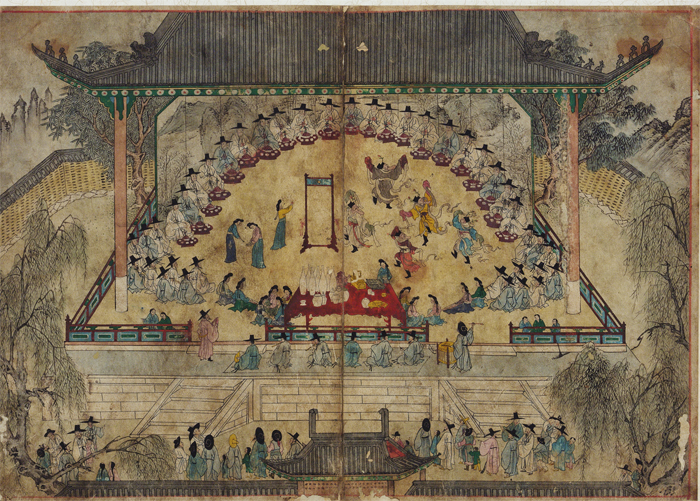
During the hyangeumjurye, people learned how to offer each other a drink and how to accept or decline an offer. The first offer is called the yecheong and the first refusal is the yesa. The second offer is the gocheong and the second refusal is the gosa. Finally, the third offer is the gangcheong and the third rejection is the jongsa. As a courtesy, an offer is no longer made after a third refusal.
The ancestors hoped that people would learn proper drinking manners at a hyangeumjurye, so that lofty human minds could exist in harmony with the influence of drink.
Giroyeon
The giroyeon is a festival originally held in honor of elderly literary officials. Only those retired literary officials above the second rank and over the age of 70 could attend the festivals which were observed on Samjinnal, the third day of the third lunar month, and on Jungyangjeol, the ninth day of the ninth lunar month. These ceremonies were aimed at promoting loyalty to the king amongst public officials and respect for elders amongst the commoners.
King Taejo (r. 1392-1398) held the first giroyeon in 1394 in commemoration of his 60th birthday, or hwangap. The observance of giroyeon was the responsibility of the Yejo, the Ministry of Rites, and a royal secretary was dispatched for the smooth organization of the festival. The king granted drinks, a musical orchestra, farmlands, salterns and slaves for the festival and prizes were given to senior members of the court.
Alcohol was the most important fare during a giroyeon, meant to celebrate longevity and to pray for health. Attendees indulged themselves in the excitement and drinks at the festival all through the day and would stagger home with the help of others late at night.
Even though involving excessive drinking, the giroyeon was carried out in accordance with strict protocols. When the king entered the ceremonial place, music was played to signal the start of the festival. After the kind was seated on the royal throne, participants went ot their places and made four ceremonial bows. After that, the attendees were divided into teams for the arrow-throwing game. The losing team had to top up the cups of the winning team, who would drink after making their ceremonial bows. From then on, the festival would start in earnest, with drinking and eating accompanied by live music. Each participant was treated to an individual tray filled with rice, soup, skewers of grilled meat, dried fish, fermented fish and kimchi, and they enjoyed multiple cups of drink from the first through to the fifth course. The festival finished with all participants making four ceremonial bows to the king.
The giroyeon was originally intended only for elderly literary officials, but started to be opened up to elderly commoners during the reign of King Yeongjo (r. 1724-1776) and King Jeongjo (r. 1776-1800). To transmit the spirit of respecting senior members of society, reenactments of the giroyeon are currently being held in some regions of the country.
*This series of article has been made possible through the cooperation of the National Research Institute of Cultural Heritage. (Source: Intangible Cultural Heritage of Korea)
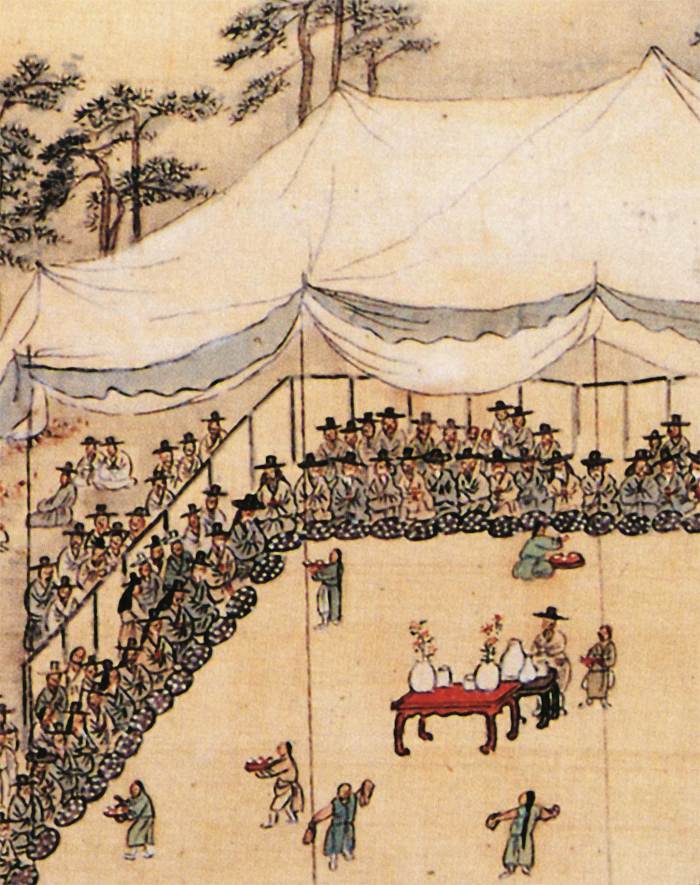
Sul and Customs
Seasonal Customs
The Korean people have long enjoyed festivals and celebrations tied to the seasonal changes throughout the year. People would give thanks to the deities or ancestral spirits and share the joy and camaraderie with their neighbors and community. Alcohol has always been an indispensible element when celebrating these seasonal customs. The drinks were made with different ingredients during the different seasons and took on different meanings on different occasions.

Farmers greeting the moon on Daeboreum, the fifteenth day of the first lunar month, from the eight-paneled folding screen “Gyeonjikdo,” or “Picture of Farming Crops and Silkworms.” Author unknown.
Dosoju, literally "liquor for fending off evil spirits," is also consumed on New Year’s Day in the belief that it would defeat spirits of misfortune throughout the year. Invented by the Chinese doctor Hwata, dosoju is made by soaking powdered medicinal ingredients, such as Chinese peppers or balloon-flower root in clear rice wine for a while, scooping them out and then boiling the medicinal liquor.
The fifteenth day of the first lunar month is Daeboreum, when Koreans drink “ear-quickening wine,” believed that it would make them quick to hear good news throughout the year. Children just sip a cup of the wine and the leftover is poured over the chimney so that evil spirits would disappear along with the smoke from the hearth.
The first day of the second lunar month is Junghwajeol which signals the start of the farming season. On Junghwajeol, festivals were held for farm servants to wish for a good harvest and they were treated to nongju, or farmers’ liquor. Youths who hadn’t yet had their coming-of-age ceremony would receive a big bowl of the liquor to signify that they were now grown-up and from that day forward they would be granted the same wage as an adult.
The third day of the third lunar month is Samjinnal when Koreans go on a picnic to enjoy the beginning of spring and flowers come into bloom. For spring picnics, the most popular alcoholic beverage is dugyeonju made of azalea flowers. Around this time of year, cheongmyeongju and gwahaju were also enjoyed. Cheongmyeongju, literally “clear clean wine,” is a kind of cheongju fermented for 21 days. It has an intense sweet flavor good even for those who don’t enjoy drinking much alcohol. Gwahaju means “liquor for getting through the summer without trouble” and it was sold at drinking houses at this time of year.
In April when the northern hemisphere is in its springtime, all living things begin to grow and farming starts in earnest. Individual households would hire one or two farm workers and form labor-sharing associations, such as durae, a type of communal agricultural team. Farm workers were treated to plentiful amounts of takju made of nuruk and rice.
The fifth day of the fifth lunar month is Dano when men traditionally play a ball game and women play on swings, and everyone enjoys the blooming nature. Women wash their hair in water boiled with iris roots and leaves, believed to chase away diseases. Iris is also used to make liquor. A pack of iris roots is steeped in cheongju so that their fragrance could be transferred to the liquor.

“Danodo,” or “Scenes on Dano Day,” by Sin Yun-bok
The fifteenth day of the sixth lunar month is Yudujeol, literally “the day when people wash their hair in water flowing to the east.” Avoiding the summer heat, Korean enjoyed drinking at a nearby stream.
The fifteenth day of the seventh lunar month is Baekjungnal. The root word baekjung literally means “among a hundred,” denoting that various kinds of fruits and vegetables are produced in large amounts around this time of year. Vegetables, fruits, rice and liquor are arranged on a table as a ritual offering for the souls of dead ancestors. Around this time when farming is on a temporary break, the “hoe cleaning” ceremony is observed when farm workers take a pleasant break feasting on food and liquor. Farm servants from the household expecting the most abundant harvest would ride a cow and roam the village to be treated to free liquor. Some would cavort around in makeshift cow costumes of straw mats, earning treats of alcohol from neighbors for their antics.

A scene of farmers and housewives carrying alcohol and food, from the eight-paneled folding screen “Gyeonjikdo,” or “Picture of Farming Crops and Silkworms.” Author unknown.
The fifteenth day of the eighth lunar month is Chuseok, or Hangawi, when Koreans set a ritual table for ancestral spirits and tend the graveyards of ancestors. After sprucing up their forefathers’ tombs, foods and liquor are shared among family members. On Chuseok, a variety of alcoholic beverages are consumed, particularly dongdongju, a kind of takju made of glutinous rice and nuruk.
The ninth day of the ninth lunar month is Jungyangjeol, a double-nine day considered auspicious, bringing about good “energy.” On this day state events were held, such as festivals honoring senior literary luminaries, and people picnicked on nearby mountains and composed poems and wrote surrounded by colorful maples and chrysanthemums. On this day, they consumed fruit salads, flower cakes and chrysanthemum liquor made by soaking chrysanthemum petals in cheongju and filtering it.
Ancestral rites are conducted to report the year’s accomplishments around the fifteenth day of the tenth lunar month. Visiting their forebears’ graveyards, Koreans conduct family rituals for up to five generations of ancestors and share the food and alcoholic beverages offered at the rites.
The last day of the twelfth month is called the “small New Year’s Day,” when Koreans send off the current year and welcome the new year. On this day, they pay tribute at ancestors’ tombs, perform ritual bows to parents and elder members of the family and share food and alcoholic beverages.
Rites of Passage
Alcohol is the most important table offering during family rituals which mark the four significant milestones: coming-of-age, weddings, funerals and ancestral rituals.
Gwallye, or Coming-of-Age Ceremonies
A gwallye is a coming-of-age ceremony to mark the transition from childhood to adulthood. Mostly taking place between the ages of 15 to 20, boys would wear a gat, a traditional Korean top hat, and girls would wear their braids secured with a binyeo, a traditional ornamental hairpin. Even though unmarried, they are received as adults after the coming-of-age ceremony.
Before the ceremony, the youth visits the family’s ancestral shrine to notify their forebears of the transition to adulthood by offering fruits and alcoholic beverages. A guest of honor is invited to preside at the ceremony and plays a similar role as a baptismal grandfather in some Christian rites. The person is normally selected from amongst friends of the head of the family and is generally a gentle and courteous guardian.
A gwallye ceremony consists of three steps. First, the celebrant wears three different types of adult attire, denoting his or her separation from childhood and his or her entrance into adulthood. Second, the new adult is given some liquor to drink. When the guest of honor offers a cup of liquor after delivering a ceremonial speech, the celebrant bows twice to the guest of honor, receives the cup, puts it on the table for a while, picks it up, takes a sip, hands it over to a ceremonial assistant and then again bows to the guest of honor. The procedure symbolizes that drinking is associated with the start of a new status or a new relationship. Third, the guest of honor endows a new name to the youth to make a fresh start as an adult.

A picture showing some of life’s milestone ceremonies. Author unknown.
At a wedding, the bride and groom exchange haphwanju, or nuptial cups. The bride offers her cup to the groom and in return the groom offers his cup to the bride. Then they exchange cups. Since nuptial cups symbolize a happy union lasting throughout life, even a bride or groom who does not want to drink should at least wet their lips from the haphwanju. After the wedding ceremony, the bride and the groom enter a room where juansang, a table set with liquor and side dishes awaits them, where they can “break the rice” between them.
Since a wedding ceremony is traditionally held at the bride’s house, the couple goes to the groom’s house after one night together. Upon arriving at the groom’s house, the bride sets a table of chicken, chestnuts, fruit and side dishes brought from her house along with alcoholic beverages.
Wedding guests are treated to honsatsul, or wedding liquor. The process of making the wedding liquor requires the utmost attention and care. Guests are expected to judge the wedding foods and the couple’s appearance, and a positive evaluation of the wedding liquor is believed to bring about a lifetime of good fortune for the newlywed couple.
Sangnye, or Funerals
Koreans do not think of death as the end of life, but believe that people would complete this life and the dead would go back to their original place of existence before they were born into this life. That is why funerals are conducted both with sorrow and pleasure.
Sangnye starts and ends with liquor. Family member, friends and neighbors visit the funeral home to offer their condolences and stay up all night drinking together as a way of sharing their sadness and warding off bad fortune.

A funeral from “The Picture Books of Genre Paintings by Gisan” by Kim Jun-geun.
About 10 people carry the coffin containing the body to the graveyard while singing. The funeral party does not head directly for the graveyard, but stops by each of the places frequented by the dead person, where a liquor table is set for a farewell ceremony, and the pallbearers and people in the funeral procession have drinks together. The coffin is finally laid in the grave and poured with liquor, and then people bow before a table set with liquor in front of the grave upon completion of the burial.
Jerye, or Ancestral Rites
Observing ancestral rites is a deeply traditional cultural practice in Korea. Ceremonial rituals for forebears are conducted on seasonal customary festivals, such as New Year’s Day, Hansik in April, Dano, Chuseok and the dates of birth and death of the ancestors. Well-off or successful families tended to carry out more ancestral rites throughout the year.
A ritual table is filled with offerings of liquor, fruit, preserved meat and cups of liquor are offered after ceremonial bows. Three cups of liquor are offered: the first by the eldest son of the family who would then read a memorial address, the second by his wife and the third by the oldest member of the family. After the third cup, the cups are filled to the brim once again and descendants step back from the table so that ancestral spirits enjoy the meal undisturbed. With the final ceremonial bow, the ritual is completed and the foods and rinks removed from the table are shared amongst the family members as a way of sharing the blessings from their ancestors.
In the past, families privately brewed their own alcoholic beverages for ancestral rituals. Koreans believed that if ritual liquor was not made properly, or if it went bad, bad fortune would come to them. Therefore, they paid every care and attention to the making of drinks for rituals.
Hyangeumjurye and Giroyeon
Hyangeumjurye
The hyangeumjurye is a ceremonial gathering of intellectuals highlighted by drinking and merrymaking, which originated in China and was introduced into Korea during the late Joseon period when 231 private schools, or hyanggyo, across the country held a yearly social gathering of Confucian scholars. Private households followed their example, inviting scholar friends to grace their gatherings. The hyangeumjurye was one of the six important Confucian rituals, along with gwallye, hollye, sangnye, jerye and sanggyeollye, or a meeting between the families fo the bride and the groom.
The purpose of the hyangeumjurye was to celebrate reverence for wisdom and to honor elders for their longevity and accomplishments. Such gatherings provided lessons on behavior, including drinking manners and demonstrating respect for other. For hyangeumjurye, the person with the highest distinction in a village played the hose and invited the village elders and adults. Participants bowed to each other whenever exchanging cups and the host circulated one cup amongst the participants to enhance the congenial atmosphere.

The “Iwongirohoedo,” or “Picture of a Gathering at Iwon.” Author unknown.
During the hyangeumjurye, people learned how to offer each other a drink and how to accept or decline an offer. The first offer is called the yecheong and the first refusal is the yesa. The second offer is the gocheong and the second refusal is the gosa. Finally, the third offer is the gangcheong and the third rejection is the jongsa. As a courtesy, an offer is no longer made after a third refusal.
The ancestors hoped that people would learn proper drinking manners at a hyangeumjurye, so that lofty human minds could exist in harmony with the influence of drink.
Giroyeon
The giroyeon is a festival originally held in honor of elderly literary officials. Only those retired literary officials above the second rank and over the age of 70 could attend the festivals which were observed on Samjinnal, the third day of the third lunar month, and on Jungyangjeol, the ninth day of the ninth lunar month. These ceremonies were aimed at promoting loyalty to the king amongst public officials and respect for elders amongst the commoners.
King Taejo (r. 1392-1398) held the first giroyeon in 1394 in commemoration of his 60th birthday, or hwangap. The observance of giroyeon was the responsibility of the Yejo, the Ministry of Rites, and a royal secretary was dispatched for the smooth organization of the festival. The king granted drinks, a musical orchestra, farmlands, salterns and slaves for the festival and prizes were given to senior members of the court.
Alcohol was the most important fare during a giroyeon, meant to celebrate longevity and to pray for health. Attendees indulged themselves in the excitement and drinks at the festival all through the day and would stagger home with the help of others late at night.
Even though involving excessive drinking, the giroyeon was carried out in accordance with strict protocols. When the king entered the ceremonial place, music was played to signal the start of the festival. After the kind was seated on the royal throne, participants went ot their places and made four ceremonial bows. After that, the attendees were divided into teams for the arrow-throwing game. The losing team had to top up the cups of the winning team, who would drink after making their ceremonial bows. From then on, the festival would start in earnest, with drinking and eating accompanied by live music. Each participant was treated to an individual tray filled with rice, soup, skewers of grilled meat, dried fish, fermented fish and kimchi, and they enjoyed multiple cups of drink from the first through to the fifth course. The festival finished with all participants making four ceremonial bows to the king.
The giroyeon was originally intended only for elderly literary officials, but started to be opened up to elderly commoners during the reign of King Yeongjo (r. 1724-1776) and King Jeongjo (r. 1776-1800). To transmit the spirit of respecting senior members of society, reenactments of the giroyeon are currently being held in some regions of the country.
*This series of article has been made possible through the cooperation of the National Research Institute of Cultural Heritage. (Source: Intangible Cultural Heritage of Korea)

The “Manwoldaegyehoedo,” or “Picture of a Gathering at Manwoldae.” Personal collection. By Kim Hong-do.
![Alcohol in Korean life [6]](/upload/content/image/1389771019931.jpg)
![Alcohol in Korean life [5]](/upload/content/image/1389148059127.jpg)
![Alcohol in Korean life [4]](/upload/content/image/1388639967163.jpg)
